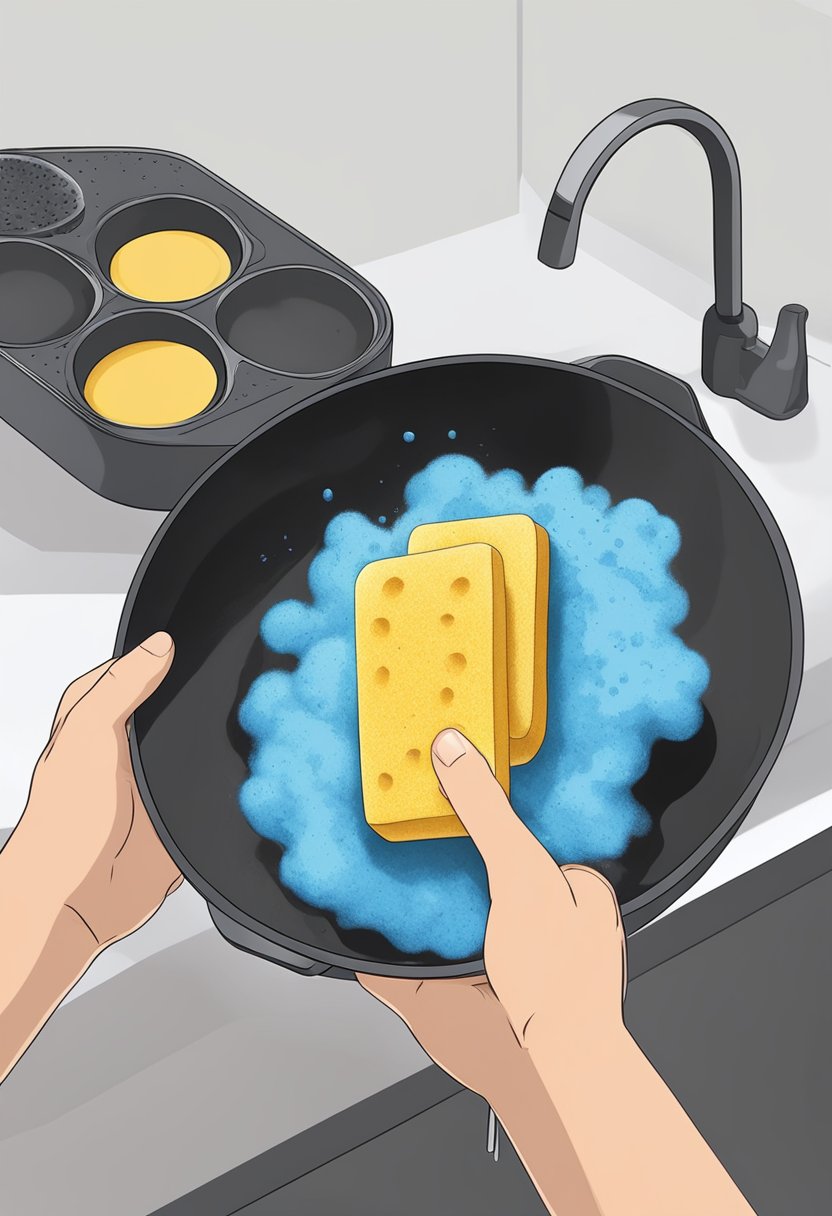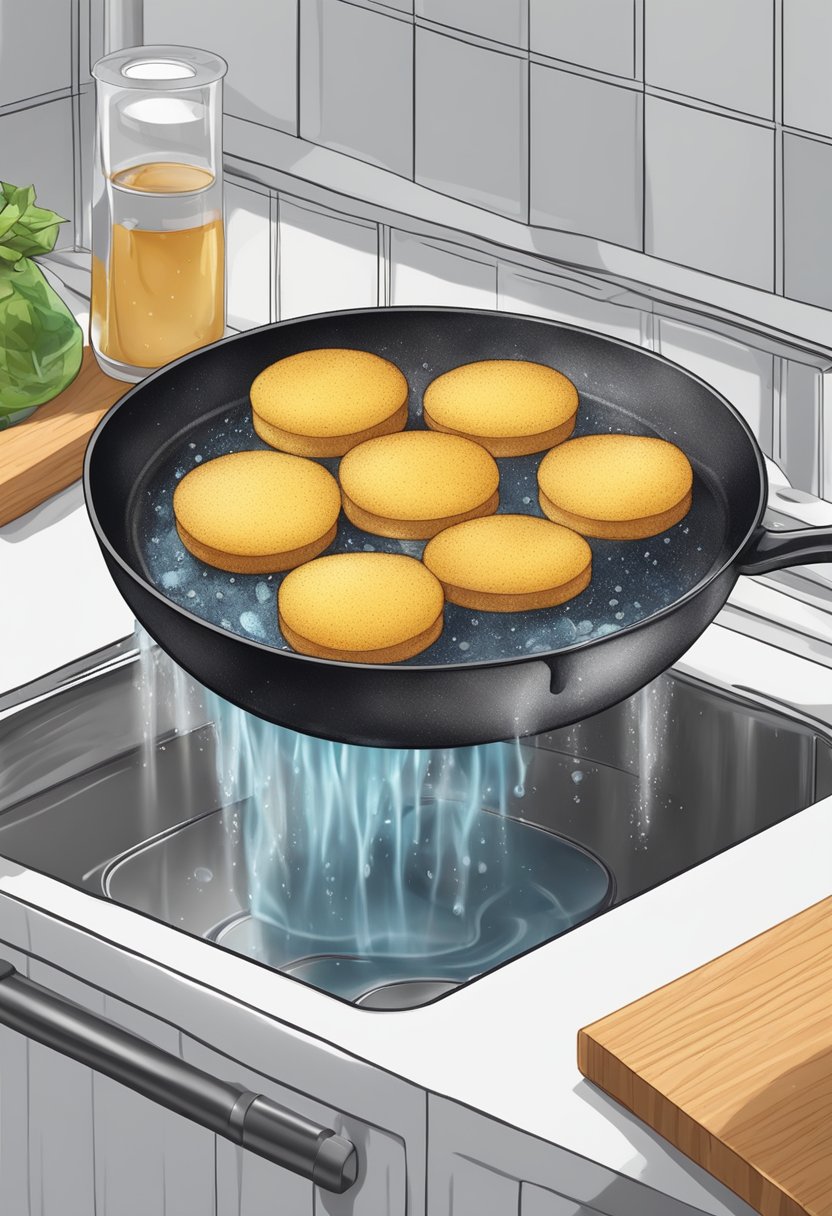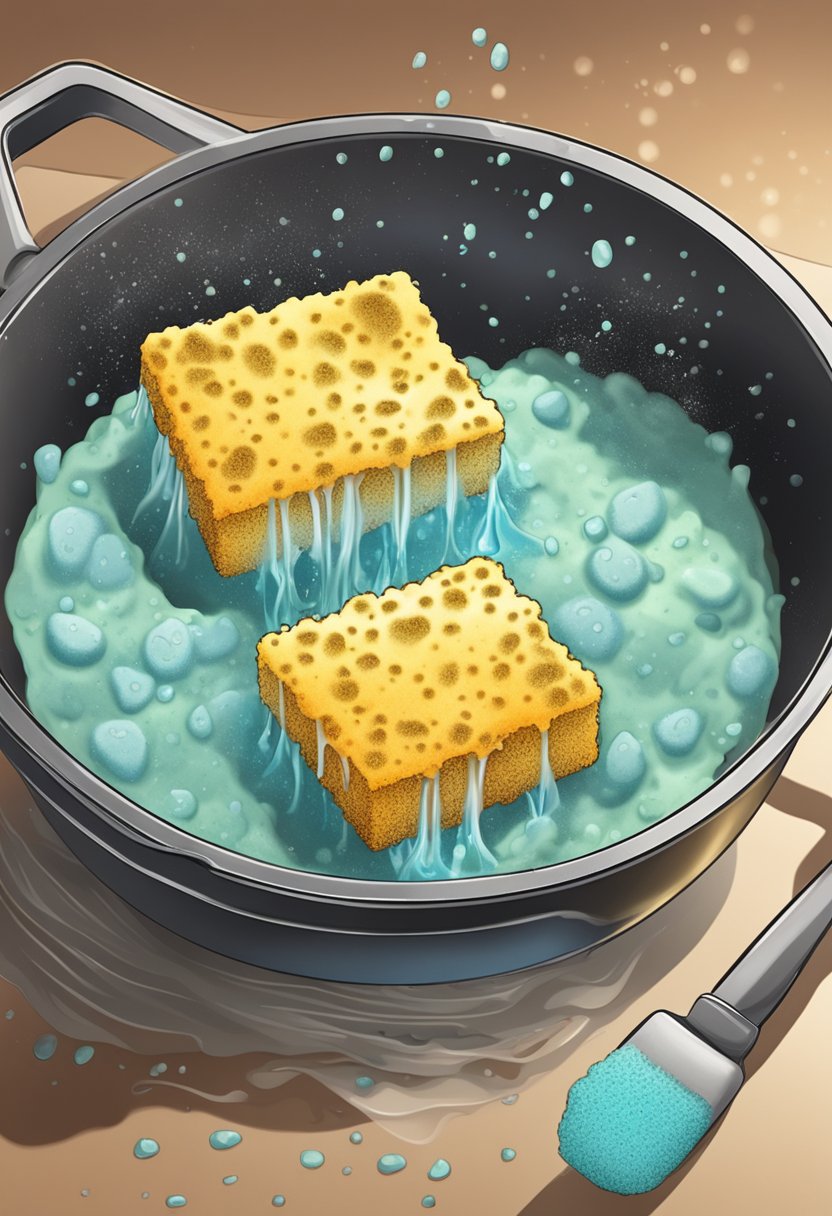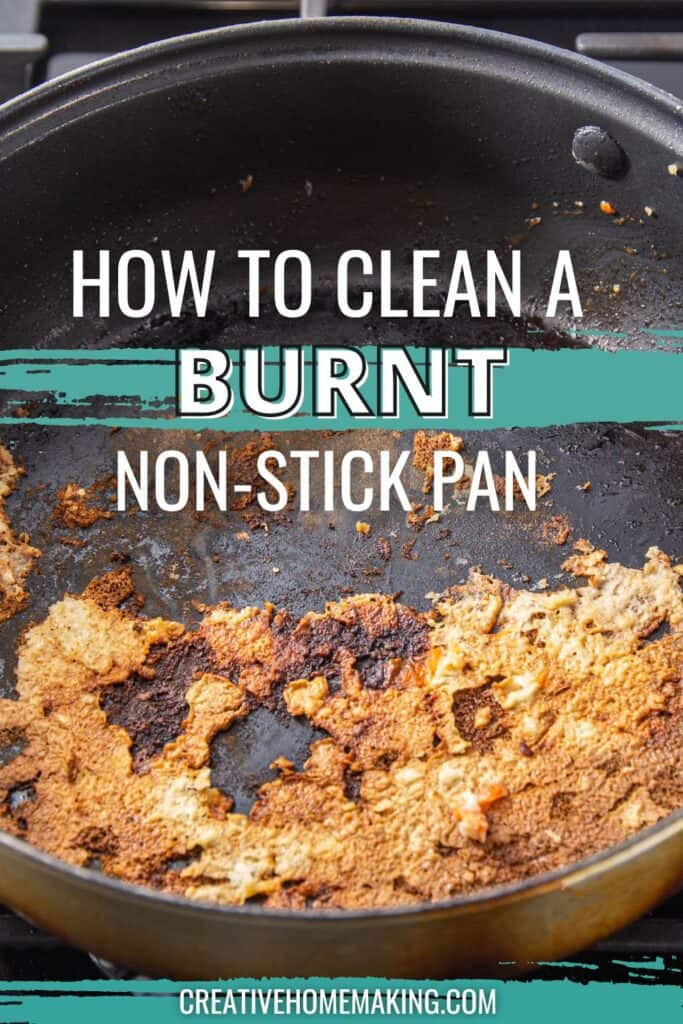Learning how to clean a burnt non-stick pan can be a daunting task, especially if you’re not sure where to start. Whether you accidentally left your pan on the stove for too long or simply forgot about it, burnt-on food can be stubborn and difficult to remove. However, with the right tools and techniques, you can easily restore your non-stick pan to its former glory.
This post may contain affiliate links.

First and foremost, it’s important to avoid using abrasive materials when cleaning a burnt non-stick pan. Metal scouring pads or harsh chemicals can scratch or damage the non-stick coating, rendering your pan less effective over time. Instead, opt for gentle cleaning solutions that won’t harm the surface of your pan.
One effective method for cleaning a burnt non-stick pan is to use a combination of baking soda and water. Simply mix the two ingredients together to form a paste, then apply it to the affected areas of your pan. Let the paste sit for a few minutes, then gently scrub the pan with a soft sponge or brush. This method can help to lift away burnt-on food without damaging the non-stick coating.
Understanding Nonstick Cookware

Nonstick cookware has become a popular choice for many home cooks due to its convenience and ease of use. However, it is important to understand the properties and limitations of nonstick pans to ensure their longevity and safety.
Types of Nonstick Coatings
There are several types of nonstick coatings available, with Teflon (polytetrafluoroethylene) being the most well-known. Other coatings include ceramic, silicone, and diamond-infused. Each type of coating has its own advantages and disadvantages, so it is important to choose the right one for your needs.
The Effects of High Heat
High heat can damage nonstick coatings, causing them to release harmful chemicals and lose their nonstick properties. It is important to avoid using high heat when cooking with nonstick pans and to never leave them on a hot burner without food.
Proper Use of Nonstick Pans
To ensure the longevity of your nonstick pan, it is important to use the right utensils. Metal utensils can scratch and damage the nonstick coating, while silicone and wooden utensils are gentler on the surface. It is also important to avoid stacking nonstick pans, as this can cause scratches and damage.
By understanding the properties and limitations of nonstick cookware, you can ensure the longevity and safety of your nonstick pans. With proper care and use, nonstick pans can be a valuable addition to any kitchen.
Preventive Measures

Cooking Temperatures
One of the most important preventive measures to take when using a non-stick pan is to avoid cooking at high temperatures. High temperatures can cause the non-stick coating to break down, resulting in a burnt pan. Instead, cook at low or medium temperatures.
Utensil Selection
The utensils you use in your non-stick pan can also affect its lifespan. Avoid using metal utensils, which can scratch the non-stick coating. Instead, use silicone, wooden, or plastic utensils. These materials are gentle on the non-stick coating and won’t cause any damage.
Routine Maintenance
Routine maintenance is key to preventing a burnt non-stick pan. After each use, allow the pan to cool down before washing it with warm soapy water. Avoid using abrasive sponges or cleaning agents, which can scratch the non-stick coating. Instead, use a soft sponge or cloth to clean the pan.
In addition to routine cleaning, seasoning your non-stick pan with a small amount of olive oil can help prevent food from sticking and prolong the life of the non-stick coating. Simply heat the pan on low heat, add a small amount of olive oil, and spread it evenly across the surface of the pan using a paper towel.
By following these preventive measures, you can keep your non-stick pan in good condition and avoid the frustration of a burnt pan.
Initial Cleaning Steps
When you accidentally burn food in a non-stick pan, it can be frustrating to clean. However, with the right approach, you can restore your pan to its former glory. Here are the initial cleaning steps you should take:
Cooling and Rinsing
After removing the burnt food from the pan, the first step is to let it cool down. Attempting to clean a hot pan can be dangerous and may cause damage to the non-stick coating. Once it has cooled, rinse it with warm water to remove any loose debris.
Wiping with Soft Materials
Next, use a soft sponge or paper towel to gently wipe the surface of the pan. Avoid using abrasive materials that could scratch the non-stick coating. If there are stubborn burnt-on stains, you can use a non-abrasive cleaner or a mixture of soap and water to help remove them.
By following these initial cleaning steps, you can begin to restore your burnt non-stick pan. Remember to avoid using harsh materials or cleaners that could damage the non-stick coating. With a little bit of effort, your pan can be as good as new.
Removing Burnt Residue
If you’ve accidentally burnt food in your non-stick pan, don’t worry! There are several effective methods to remove burnt residue without damaging the non-stick coating. Here are some techniques you can try:
Soaking Techniques
Soaking your pan in a solution of warm water and vinegar or baking soda can help loosen burnt residue. Fill the pan with enough water to cover the burnt areas, then add a cup of vinegar or a tablespoon of baking soda. Let the pan soak for several hours or overnight. Afterward, use a sponge or brush to gently scrub away the residue. Rinse the pan with soapy water and dry it thoroughly.
Another soaking technique is to fill the pan with hot water and add a tablespoon of salt. Let the pan soak for at least 30 minutes, then scrub away the residue with a sponge or brush. Rinse the pan with soapy water and dry it thoroughly.
Gentle Scrubbing Methods
For light burnt residue, you can try using a sponge or brush with a non-abrasive scrubber. Wet the sponge or brush and apply a small amount of dish soap. Gently scrub the burnt areas in a circular motion until the residue is removed. Rinse the pan with water and dry it thoroughly.
Homemade Cleaning Solutions
You can also make your own cleaning solution with ingredients you may already have at home. For example, mix equal parts of baking soda and water to create a paste. Apply the paste to the burnt areas and let it sit for 10-15 minutes. Scrub the residue away with a sponge or brush, then rinse the pan with water and dry it thoroughly.
Another homemade solution is to cut a lemon in half and use it to scrub the burnt areas. The acid in the lemon can help dissolve the residue. Alternatively, you can sprinkle sea salt over the burnt areas and use a sponge or brush to scrub the residue away.
By using these techniques, you can effectively remove burnt residue from your non-stick pan without causing any damage. Remember to always rinse and dry your pan thoroughly after cleaning to prevent any water spots or rust.
Addressing Stubborn Stains
When it comes to cleaning a burnt non-stick pan, stubborn stains can be a real headache. However, with the right techniques, you can get your pan looking like new again. Here are some effective methods for addressing stubborn stains:
Using Baking Soda Paste
One of the most effective ways to remove stubborn burnt-on food is by using a baking soda paste. To make the paste, mix equal parts baking soda and water until it forms a thick, spreadable paste. Apply the paste to the stained areas of your pan and let it sit for at least 30 minutes. Then, scrub the pan with a non-abrasive sponge or brush and rinse it thoroughly with water. This method works well for most types of non-stick pans and is gentle enough not to damage the surface.
Simmering with Vinegar
Another effective method for removing stubborn stains is by simmering the pan with vinegar. Fill the pan with equal parts water and white vinegar, then bring it to a simmer. Let the mixture simmer for 10-15 minutes, then remove it from the heat and let it cool. Once the pan is cool enough to handle, scrub it with a non-abrasive sponge or brush and rinse it thoroughly with water. The acidity of the vinegar helps to break down the burnt-on food, making it easier to remove.
By using these effective methods, you can remove stubborn burnt-on food from your non-stick pan and restore it to its former glory. Remember to always be gentle with your pan to avoid damaging the non-stick surface, and avoid using abrasive sponges or harsh chemicals like dishwasher detergent.
Caring for Your Nonstick Pan
Taking care of your nonstick pan is crucial to ensure that it lasts a long time and continues to function properly. Here are some tips on how to care for your nonstick pan:
Regular Cleaning
Cleaning your nonstick pan after each use is important to remove any leftover food particles and prevent buildup. To clean your pan, use a soft sponge or microfiber cloth with warm water and dish soap. Avoid using steel wool or abrasive sponges as they can scratch the nonstick surface and remove the coating.
Avoiding Scratches
Scratches on your nonstick pan can cause the coating to peel off and reduce its effectiveness. To avoid scratches, use wooden or silicone utensils when cooking and avoid using metal utensils. Also, avoid stacking your nonstick pans on top of each other as this can cause scratches.
When to Replace
Over time, the nonstick coating on your pan may wear off, making it harder to clean and reducing its nonstick properties. If you notice that your pan is no longer nonstick or has scratches, it may be time to replace it. It is recommended to replace your nonstick pan every 3-5 years, depending on how often you use it.
Best Practices for Longevity
When it comes to non-stick pans, proper care and maintenance can significantly increase their lifespan. Here are some best practices to follow:
Proper Storage
Storing your non-stick pans properly is crucial to prevent scratches and damage. To avoid stacking them, you can hang them from a pot rack or store them separately with a soft cloth or paper towel between each pan. This will not only prevent scratches but also help maintain the non-stick coating.
Safe Dishwashing
While some non-stick pans are dishwasher-safe, it’s always best to hand wash them. Dishwashers can cause scratches and damage to the non-stick coating, reducing its effectiveness. When hand washing, use a non-abrasive sponge or cloth and avoid using steel wool or harsh cleaning agents.
Periodic Seasoning
Periodic seasoning can help maintain the non-stick coating and prevent food from sticking. To season your non-stick pan, heat it over medium heat and add a small amount of vegetable-based oil. Spread the oil evenly with a paper towel and let it cool. Repeat this process every few months or as needed.
By following these best practices, you can ensure that your non-stick pans last longer and perform better. Remember to always use non-abrasive cooking utensils and avoid using high heat settings, which can damage the non-stick coating.
Frequently Asked Questions
What is the best method to clean and restore a burnt non-stick pan?
The best method to clean and restore a burnt non-stick pan is to use a mixture of baking soda and water. This mixture can help to break down the burnt-on food and restore the non-stick surface of the pan.
Can a burnt non-stick pan still be safely used for cooking?
It is not recommended to use a burnt non-stick pan for cooking as the burnt-on food can release harmful fumes when heated. Additionally, the non-stick coating may have been compromised, making it more likely for food to stick and burn in the future.
What steps should be taken to clean a non-stick pan for the first time?
When cleaning a non-stick pan for the first time, it is important to avoid using abrasive cleaners or scrubbers that can scratch the surface. Instead, use a soft sponge or cloth with mild dish soap and warm water. Rinse thoroughly and dry with a soft towel.
How can baking soda and vinegar be used to clean a non-stick pan?
To use baking soda and vinegar to clean a non-stick pan, first sprinkle baking soda over the burnt-on food. Then, pour vinegar over the baking soda to create a fizzing reaction. Let the mixture sit for a few minutes before scrubbing with a soft sponge or cloth. Rinse thoroughly and dry with a soft towel.
What are the risks associated with fumes from a burnt non-stick pan?
The fumes from a burnt non-stick pan can be harmful if inhaled. These fumes can cause flu-like symptoms, such as headache, fever, and chills. It is important to avoid using a burnt non-stick pan and to properly clean and maintain non-stick cookware.
Is it effective to use salt for cleaning the bottom of a non-stick pan?
Using salt to clean the bottom of a non-stick pan is not recommended as it can scratch the surface and damage the non-stick coating. Instead, use a soft sponge or cloth with mild dish soap and warm water to clean the pan.
Follow my cleaning hacks board on Pinterest.




Lemon juice works